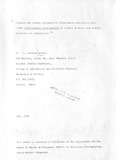| dc.description.abstract | This thesis records in part the search for a technique to identify
mares with lowered resistance to Streptococcal endometritis. It
also presents the findings of studies on the pathogenesis of equine
Streptococcal endometritis, including the factors influencing the
elimination of the experimentally infused Streptococcus zooepidemicus.
Acute endometritis was induced in 32 mares, which were classified as
either resistant (21) or susceptible (11) to endometritis depending
on their breeding histories and the degree and extent of endometrial
pathology. Infection was induced by intrauterine inoculation of 109
viable~. zooepidemicus suspended 1n 2 mls of sterile isotonic
mannitol solution. Three control mares were infused with 10 mls of
sterile isotonic mannitol. Serial uterine swabs, washings and
biopsies and blood samples were obtained before (0 hrs), and at
fixed time intervals after intrauterine infusion of the Streptococci
inoculum (2, 3, 4, 6, 9, 12 and 15 hrs and 1, 2, 4, 6, 10, 14 and
28 days).
The findings of physical examination and the results obtained from
the serial samples were used to assess the degree, extent and duration
of the inflammatory reaction and immune response, endometrial damage
and the persistence of the infused Streptococci 1n the uterus.
The major findings of the present study were:-
1) A predominantly neutrophilic response, which did not differ
significantly between resistant and susceptible mares was observed
within 2 hours of challenge. Neutrophil function tests indicated
that there were no significant differences in the chemotactic,
phagocytic and intracellular killing ability of both circulating and
uterine neutrophils obtained from resistant and susceptible mares.
Uterine washings obtained before and after challenge from both
resistant and susceptible mares did not enhance phagocytosis.
2) An influx of serum proteins including immunoglobulin A, G,
G(T) and traces of M, which reached a peak between 6 and 24 hours of
challenge, was observed in all challenged and control mares. IgA and
IgG concentrations in uterine washings obtained from the challenged
mares, were significantly higher than those measured ~n uterine
washings obtained from control mares. This finding and the observation
that persisting infection resulted in continuing high levels of IgA
indicated that the IgA was produced in response to the infused
Streptococci. There was, however, no significant difference between
the total protein concentrations in uterine washings and fluid
obtained from resistant and susceptible mares. The concentrations
of ceruloplasmin and alfa 2 - globulins, both documented modulators
of inflammation, reached their highest levels between 6 and 24 hours
after challenge. In contrast the concentrations of trypsin inhibitors,
(also documented modulators of inflammation), remained unchanged
throughout the observation period.
3) The stage of the oestrous cycle at challenge was determined
using plasma progesterone levels (measured by the enzyme immunoassay
(EIA», clinical and physical examination findings and histological
findings in uterine biosies obtained 10 days after challenge. Data
available from the present study indicated that the stage of the
oestrous cycle at challenge did not influence the response to
Streptococcal challenge or the persistence of infection.
4) Light and electron microscopic studies showed that the degree
and extent of cellular infiltration into the endometrium and the
extent of uterine luminal epithelial damage after challenge was
similar in both resistant and susceptible mares.
From the data obtained in the present investigations it was concluded
that repeated uterine infections, in mares with lowered resistance
to endometritis (susceptible), occured ln the presence of IgA and
that although these mares were capable of subsequently mounting a
local immune response that was comparable to that mounted by the
resistant mares, they were still unable to eliminate the infused
Streptococci. This inability to resolve the experimentally induced
endometritis was, however, not due to gross disorders in neutrophil
function, lack of immunoglobulins or natural modulators of inflammation
and neither was it dependent on the stage of the oestrous cycle at
challenge. | en |

